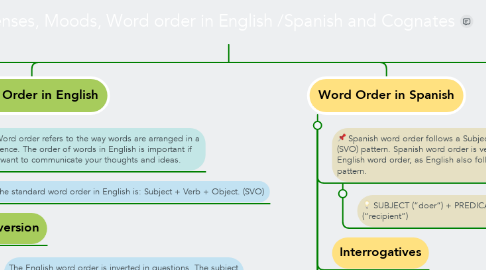
1. Tenses and Moods English/Spanish
1.1. Verb tenses are those grammatical models of verbal conjugation that place an action or a state in time.
1.1.1. Mood is used to refer to a verb category or form which indicates whether the verb expresses a fact.
1.2. Verb Tenses in English
1.2.1. Simple Present, Simple Past, Simple Future
1.2.1.1. Present Continuous, Past Continuous, Future Continuous
1.2.1.2. Present Perfect Continuous, Past Perfect Continuous, Future Perfect Continuous
1.3. Mood in English
1.3.1. • The indicative, imperative, interrogative, subjunctive mood
1.4. Verb Tenses in Spanish
1.4.1. Presente
1.4.2. Pretérito perfecto (Pasado y Presente) Pretérito imperfecto (Pasado)
1.4.3. Pretérito indefinido (Pasado) Pretérito pluscuamperfecto (Pasado)
1.5. Mood in English
1.5.1. • Indicativo, subjuntivo, imperativo
2. Word Order in English
2.1. Word order refers to the way words are arranged in a sentence. The order of words in English is important if you want to communicate your thoughts and ideas.
2.2. The standard word order in English is: Subject + Verb + Object. (SVO)
2.3. Inversion
2.3.1. The English word order is inverted in questions. The subject changes its place in a question.
2.3.1.1. For example: Verb + Subject + object Can you finish the assignment?
2.4. Intransitive Verbs
2.4.1. Some sentences use verbs that require no object or nothing else to follow them.
2.4.1.1. For example: Subject + verb / John eats.
2.5. Indirect Objects
2.5.1. Indirect objects are usually the receiver of the action or the audience of the direct object.
2.5.1.1. For example: Subject + Verb + Indirect Object + Direct Object He gave the man a good job.
2.6. Adverbials
2.6.1. Adverbs are phrases or words that modify or qualify a verb, adjective, or other adverbs.
2.6.1.1. For example: He hurriedly ate his food.
2.7. Adjectives
2.7.1. Adjectives commonly refer to words that are used to describe someone or something.
2.7.1.1. For example: She is beautiful.
3. Word Order in Spanish
3.1. Spanish word order follows a Subject-Verb Object (SVO) pattern. Spanish word order is very similar to English word order, as English also follows SVO pattern.
3.1.1. SUBJECT (“doer“) + PREDICATE (“action”) + OBJECT (“recipient”)
3.2. Interrogatives
3.2.1. Interrogatives are questions. In general, when asking questions in Spanish, the order of the subject and the verb are reversed.
3.2.1.1. Example: ¿Por qué hablan los colombianos tan rápido? Why do Colombians speak so rapidly?
3.3. Indirect object
3.3.1. Nouns and pronouns tell to whom or for whom an action is performed
3.3.1.1. Example: Ana bañó al perro. /Ana bathed the dog.
3.4. Negative
3.4.1. No hay nadie. → “There isn’t anyone.”
3.5. Prepositional Phrases
3.5.1. Example: Estudio español en casa. → “I study Spanish at home.”
3.6. Direct object
3.6.1. Quieren una casa nueva. → “They want a new house.”
4. Cognates and False Cognates
4.1. A cognate is a word that has the same linguistic derivation as another.
4.2. Perfect Cognates
4.2.1. They are exactly what they sound like, words that are spelled the same and have the same meaning, but note, they may be pronounced differently.
4.2.1.1. Examples: English / Spanish
4.2.1.1.1. Criminal / Criminal Animal / Animal Control / Control
4.3. False Cognates
4.3.1. Also known as “false friends”, are words that are spelled the same or similar, but have a completely different meaning.
4.3.1.1. Examples: English / Spanish
4.3.1.1.1. Librería = bookstore Not Library Actual = current Not actual Realizar = perform Not realize
